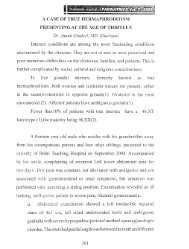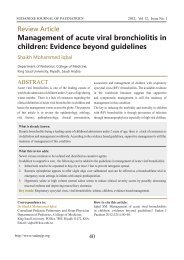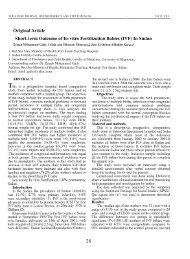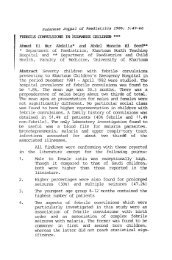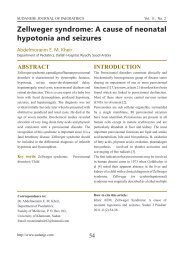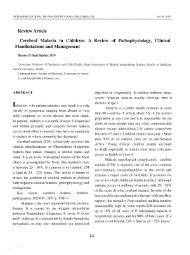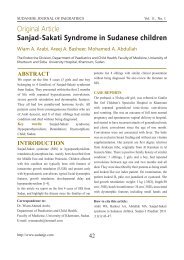conference programme and abstracts book - Sudanjp.org
conference programme and abstracts book - Sudanjp.org
conference programme and abstracts book - Sudanjp.org
You also want an ePaper? Increase the reach of your titles
YUMPU automatically turns print PDFs into web optimized ePapers that Google loves.
Patterns of Severe Malaria in Sudanese ChildrenZeidan Zl, Kojal H2, Habour M3,Nowary K4, Hashim F5, Erikson 861Associate Professor, Community Medicine Department, University of Khartoum2Assistant Professor, Paediatrician, University of Islami a3Pro(essor, Paediatrician, University ofGezira4Paediatrician, Gedarif Hospital5Paediatrician, Sinnar HospitalNordic School of Public HealthCorrespondence:Zeidan Abdu, Zeidan, Associate Professor, University of Khartoum, Community, Medicine Department,PO Box 102, Khartoum, SudanThe objective of this study was to assess treatment actions before admission lex severemalaria, epidemiology, clinical presentation, disease management, outcome <strong>and</strong> risk factorsassociated with fatality.Follow up prospective design was used to fulfil the objectives of the study that took place infour hospitals: Omdurman Paediatrics hospital located in the capital (Khartoum) Comparedto Medani, Gedarif <strong>and</strong> Sennar hospitals located in other states.Total admission of severe malaria was 543 children; it represented 21% of all paediatric admission,<strong>and</strong> 12% of malaria outpatient cases. Madigan age of children with severe malariawas 48 months. 93% of children with severe malaria died before the age of 9 years. Treatmentat home was the first action taken by families before hospitalization (58%), majorityof actions (75%) were done by mothers. Health services at local level were available onlyfor 34% of the largest groups. Cerebral malaria judged by convulsion <strong>and</strong> eoma (83%) wasthe commonest complication; it had significantly different distribution in different stats i.e.with different epidemiological context.Case fatality rate was 26/1 000. Risk of dying because of delay was four more times comparedto children without delay, 95% Cl (1.5 - 14.3). Highest risk of death was associatedwith delay in seeking treatment <strong>and</strong> severity of the illness before admission (coma, inabilityto sit or eat <strong>and</strong> hyperpyrexia).IOmdurman hospital in Khartoum state (the capital) witnessed the highest case managementperformance index compared to other states hospitals.In view of this, we conclude that malaria could be reduced by improving peripheral healthfacilities, train mothers on malaria home management <strong>and</strong> providing appropriate educationto communities to avoid delay in seeking treatment. Malaria control strategy should considerthe different epidemiological contexts in different states in Sudan.



